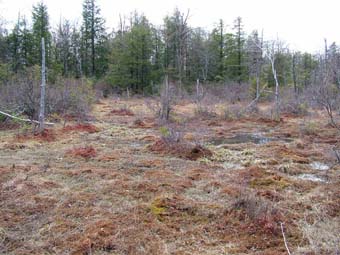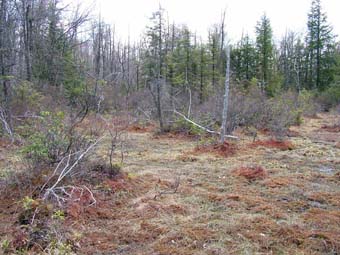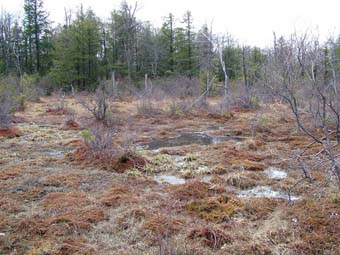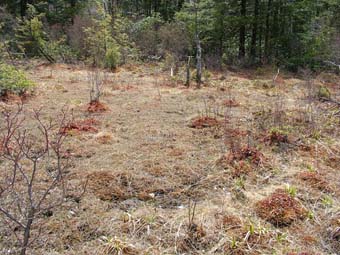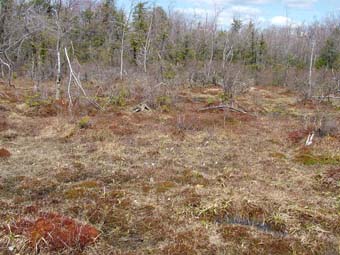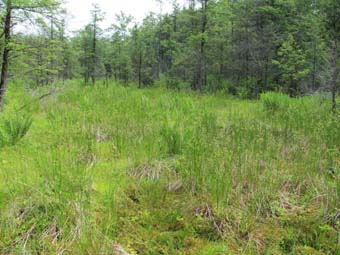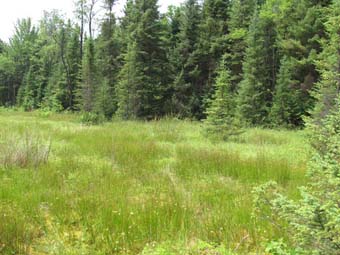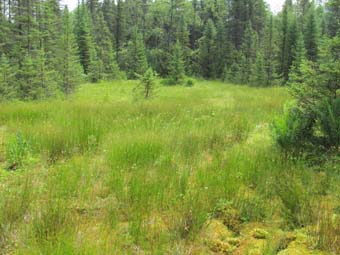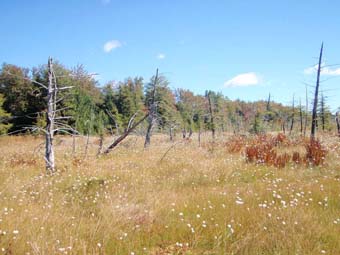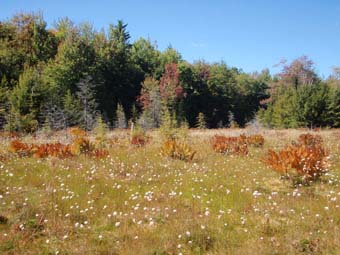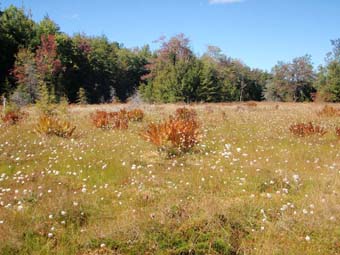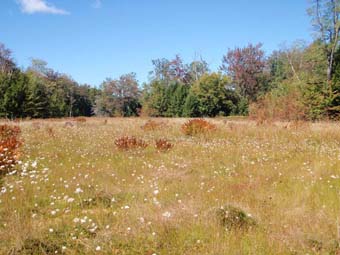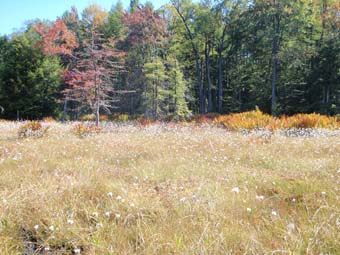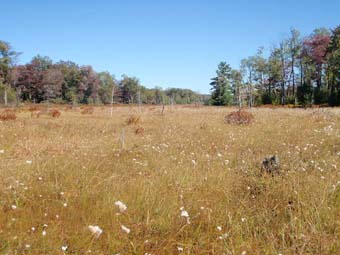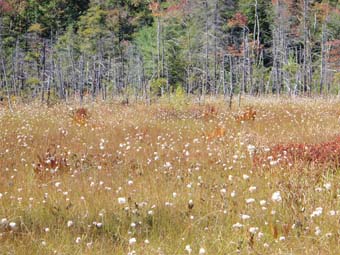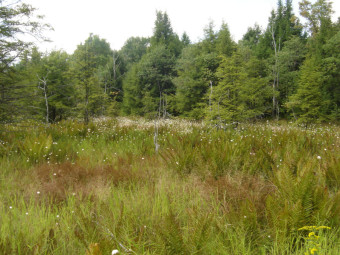Cotton-grass Poor Fen
System: Palustrine
Subsystem: Herbaceous
PA Ecological Group(s): Peatland Wetland
Global Rank:G3
![]() rank interpretation
rank interpretation
State Rank: S3
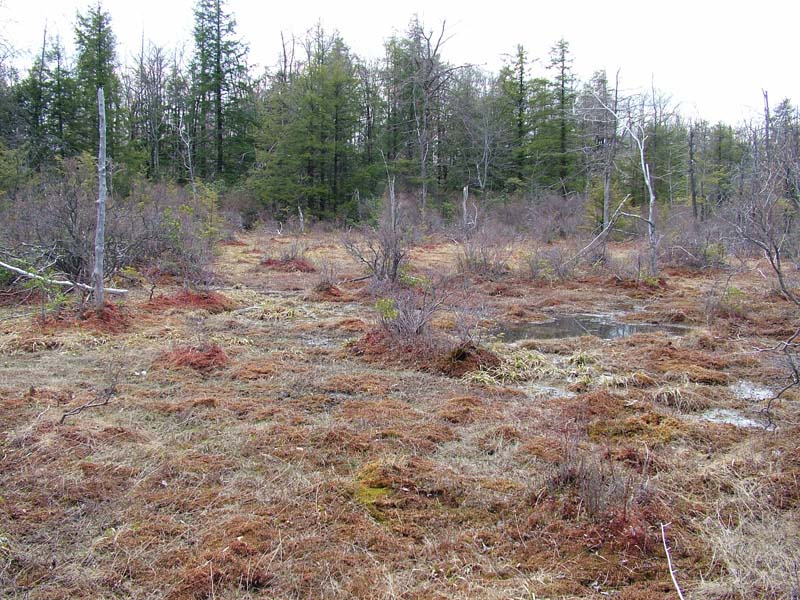
General Description
This acidic herbaceous community occurs on temporarily flooded, semi-permanently flooded or saturated peat at relatively high elevations. Cotton-grass Poor Fens are often referred to as bogs, and in fact the degree of groundwater influence is variable and usually much lower than for other fen communities. They often occur in small-patches, and occupy flat-lying land (0- to 1-degree slopes) in headwater basins. Bedrock is sometimes exposed in places, creating a mosaic that includes dry patches with lowbush blueberry (Vaccinium angustifolium), certain lycopods (especially Lycopodium clavatum and Diphasiastrum digitatum), and other upland species. The community is typically dominated by a combination of tawny cotton-grass (Eriophorum virginicum), sedge (Carex folliculata), soft rush (Juncus effusus), narrow-panicled rush (Juncus brevicaudatus), and cinnamon fern (Osmunda cinnamomea). Other herbaceous species may include sedge (Carex trisperma), round-leaved sundew (Drosera rotundifolia), wool-grass (Scirpus cyperinus), and white beak-rush (Rhynchospora alba).
Older stands typically occur over shallow bedrock, where they are kept open by high water tables. Younger stands often occur in beaver-influenced wetland mosaics, often behind breached dams on the site of former beaver ponds. The type also occurs as a successional community on formerly forested peatlands that have been logged and/or burned within the last century. Hummock and hollow microtopography can be moderately well-developed, and bedrock is typically acidic sandstone and, less commonly, shale. The substrate is poorly to very poorly drained peat or muck. Peat deposits are shallow, ranging from 10-75 cm in depth, underlain by clay-rich soils or bedrock.
Rank Justification
Vulnerable in the jurisdiction due to a restricted range, relatively few populations, recent and widespread declines, or other factors making it vulnerable to extirpation.
Identification
- Saturated for much or most of the year, usually wet and springy to the touch.
- High cover of peat (Sphagnum spp.) or haircap (Polytrichum spp.) moss.
- Tawny cotton-grass (Eriophorum virginicum) present, co-dominant at least in patches.
- Occurs in high-elevation headwaters basins of non-glaciated regions, often where bedrock is shallow
- Peat layer may be shallow (ranging 10 – 75 cm).
- Woody vegetation is rare or absent
Herbs
- Tawny cotton-grass (Eriophorum virginicum)
- Sedge (Carex folliculata)
- Sedge (Carex trisperma)
- Soft rush (Juncus effusus)
- Cinnamon fern (Osmunda cinnamomea)
- Northern bog clubmoss (Lycopodiella inundata)
- Round-leaved sundew (Drosera rotundifolia)
- Wool-grass (Scirpus cyperinus)
- White beak-rush (Rhynchospora alba)
Bryophytes
* limited to sites with higher soil calcium
Vascular plant nomenclature follows Rhoads and Block (2007). Bryophyte nomenclature follows Crum and Anderson (1981).
International Vegetation Classification Associations:
USNVC Crosswalk:None
Representative Community Types:
Cottongrass Bog (CEGL006570)
NatureServe Ecological Systems:
High Allegheny Wetland (CES202.069)
NatureServe Group Level:
None
Origin of Concept
Fike, J. 1999. Terrestrial and palustrine plant communities of Pennsylvania. Pennsylvania Natural Diversity Inventory. Pennsylvania Department of Conservation and Recreation, Bureau of Forestry, Harrisburg, PA. 86 pp.
Pennsylvania Community Code*
na : Not Available
*(DCNR 1999, Stone 2006)
Similar Ecological Communities
The Sphagnum – Beak-rush Peatland community occurs in glaciated areas of Pennsylvania. Although sphagnum (Sphagnum spp.), tawny cotton-grass (Eriophorum virginicum), and beak rush species (Rhynchospora spp.) are important in both types, they differ in the overall species composition and in the environmental setting with the Cotton-grass Poor Fen being heavily dominated by tawny cotton-grass (Eriophorum virginicum) and rushes (Juncus spp.) and Sphagnum – Beak-rush Peatland being dominated by white beak-rush (Rhynchospora alba). Degraded Sphagnum – Beak-rush Peatland may occur as Cotton-grass Poor Fens.
Fike Crosswalk
None. This type is new to the Pennsylvania Plant Community Classification developed from PNHP inventory studies.
Conservation Value
The wetlands that Cotton-grass Poor Fens are a part of host a unique assemblage of plant and animal species, including some rare plants and insects such as the creeping snowberry (Gaultheria hispidula), bog sedge (Carex paupercula), northern pygmy clubtail (Lanthus parvulus), ocellated darner (Boyeria grafiana), ski-tailed emerald (Somatachlora elongata), Appalachian jewelwing (Calopterysx angustipennis), and superb jewelwing (Calopteryx amata).
Threats
Alteration to the hydrological regime such as impoundments, diking, draining, and beaver dams can lead to habitat destruction and/or shifts in community function and dynamics. However, beaver have been a part of these ecosystems, thus many of the component species of this community are adapted to the cyclical community shifts caused by beaver. Clearing and development of adjacent land can lead to an accumulation of agricultural run-off and pollution as well as sedimentation.
Management
A natural buffer should be maintained around wetlands in order to minimize nutrient runoff, pollution, and sedimentation. Buffer design should consider factors such as the slope of adjacent lands, soil erosion potential, the migration distance of amphibians and insect species using the wetlands, and the condition of surrounding vegetation. Direct impacts and habitat alteration should be avoided (e.g., roads, trails, filling of wetlands) and low impact alternatives (e.g., elevated footpaths, boardwalks, bridges) should be utilized in situations where accessing the wetland can not be avoided. Care should also be taken to control and prevent the spread of invasive species within the wetland.
Research Needs
The process of succession in these wetlands, which may maintain the Cotton-grass Poor Fen over time or result in natural transition to shrub or forest wetlands, is also not well understood. It is important to understand the impact of fire, logging, and changes in beaver population density on the successional process.
Trends
While this is considered a naturally occurring wetland community, occurrences of Cotton-grass poor fen communities expanded following extensive logging and fires that occurred in the late 19th and early 20th centuries that impacted most forested wetlands. The almost complete extirpation of the beaver in central Pennsylvania in the late 19th century, and its subsequent population recovery in the second half of the 20th century, also contributed to the number of occurrences and extent of these wetlands. It is known generally that fire, logging, and beaver activity can all influence water levels and plant community structure in wetlands, changing the suitability of the wetland as habitat for many species. However, the full effects and long term impacts of these changes are not known.
Range Map
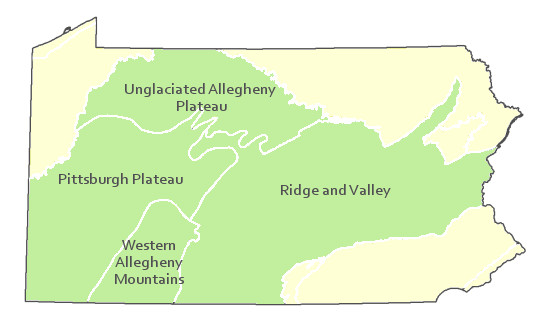
Pennsylvania Range
Central Pennsylvania – high elevations in the ridge and valley, Allegheny Mountains, and high Allegheny plateau physiographic provinces.
Global Distribution
Maryland, Pennsylvania, and West Virginia.
Byers, E. A., J. P. Vanderhorst, and B. P. Streets. 2007. Classification and conservation assessment of high elevation wetland communities in the Allegheny Mountains of West Virginia. West Virginia Natural Heritage Program, West Virginia Division of Natural Resources, Elkins.
CAP [Central Appalachian Forest Working Group]. 1998. Central Appalachian Working group discussions. The Nature Conservancy, Boston, MA.
Clancy, K. 1996. Natural communities of Delaware. Unpublished review draft. Delaware Natural Heritage Program, Division of Fish and Wildlife, Delaware Division of Natural Resources and Environmental Control, Smyrna, DE. 52 pp.
Cowardin, L. M., V. Carter, F. C. Golet, and E. T. LaRoe. 1979. Classification of wetlands and deepwater habitats of the United States. U.S. Fish and Wildlife Service, Biological Service Program. FWS/OBS-79/31. Washington, DC. 103 pp.
Eastern Ecology Working Group of NatureServe. No date. International Ecological Classification Standard: International Vegetation Classification. Terrestrial Vegetation. NatureServe, Boston, MA.
Edinger, G. J., D. J. Evans, S. Gebauer, T. G. Howard, D. M. Hunt, and A. M. Olivero, editors. 2002. Ecological communities of New York state. Second edition. A revised and expanded edition of Carol Reschke's ecological communities of New York state. (Draft for review). New York Natural Heritage Program, New York State Department of Environmental Conservation, Albany, NY.
Fike, J. 1999. Terrestrial and palustrine plant communities of Pennsylvania. Pennsylvania Natural Diversity Inventory. Pennsylvania Department of Conservation and Recreation. Bureau of Forestry. Harrisburg, PA. 86 pp.
Gawler, S. C. 2002. Natural landscapes of Maine: A guide to vegetated natural communities and ecosystems. Maine Natural Areas Program, Department of Conservation, Augusta, ME. [in press]
Harrison, J. W., compiler. 2004. Classification of vegetation communities of Maryland: First iteration. A subset of the International Classification of Ecological Communities: Terrestrial Vegetation of the United States, NatureServe. Maryland Natural Heritage Program, Maryland Department of Natural Resources, Annapolis. 243 pp.
Hill, A. F. 1923. The vegetation of the Penobscot Bay region, Maine. Proceedings of the Portland Society of Natural History 3:307-438.
NatureServe 2010. NatureServe Explorer: An online encyclopedia of life Version 7.1. NatureServe, Arlington, VA. Available http://www.natureserv.org/explorer (accessed: 23 November 2011).
Northern Appalachian Ecology Working Group. 2000. Northern Appalachian / Boreal Ecoregion community classification (Review Draft). The Nature Conservancy, Eastern Conservation Science Center, Boston, MA. 117 pp. plus appendices.
Pennsylvania Department of Conservation and Natural Resources (DCNR). 1999. Inventory Manual of Procedure. For the Fourth State Forest Management Plan. Pennsylvania Bureau of Forestry, Division of Forest Advisory Service. Harrisburg, PA. 51 ppg.
Sperduto, D. D. 2000b. A classification of wetland natural communities in New Hampshire. New Hampshire Natural Heritage Inventory, Department of Resources and Economic Development, Division of Forests and Lands. Concord, NH. 156 pp.
Stone, B., D. Gustafson, and B. Jones. 2006 (revised). Manual of Procedure for State Game Land Cover Typing. Commonwealth of Pennsylvania Game Commission, Bureau of Wildlife Habitat Management, Forest Inventory and Analysis Section, Forestry Division. Harrisburg, PA. 79 ppg.
Swain, P. C., and J. B. Kearsley. 2000. Classification of natural communities of Massachusetts. July 2000 draft. Natural Heritage and Endangered Species Program, Massachusetts Division of Fisheries and Wildlife. Westborough, MA.
Thompson, E. 1996. Natural communities of Vermont uplands and wetland. Nongame and Natural Heritage Program, Department of Fish and Wildlife in cooperation with The Nature Conservancy, Vermont chapter. 34 pp.
Thompson, E. H., and E. R. Sorenson. 2000. Wetland, woodland, wildland: A guide to the natural communities of Vermont. The Nature Conservancy and the Vermont Department of Fish and Wildlife. University Press of New England, Hanover, NH. 456 pp.
Tiner, R.W. 1990. Pennsylvania’s Wetlands: Current Status and Recent Trends. U. S. Fish and Wildlife Service report, 104 pp.
Cite as:
Mcpherson, J. 2022. Pennsylvania Natural Heritage Program. Cotton-grass Poor Fen Factsheet. Available from: https://www.naturalheritage.state.pa.us/Community.aspx?=30006 Date Accessed: January 13, 2026

